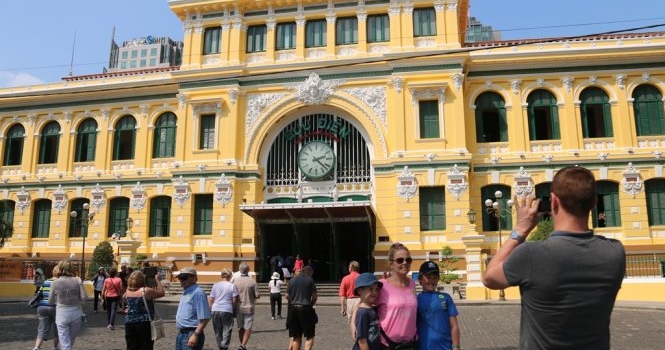Hoi An and My Son Sanctuary day tour
This full day trip features a walking tour of Hoi An Town and My Son sanctuary. Hoi An is an exceptionally well- [caption id="attachment_1040" align="alignright" width="277"] My Son tour[/caption] preserved...

Ho Chi Minh City (Former name Saigon) – The French nickname their dear city, “Pearl of the far East”. Chinese immigrants call it “Cho Lon”, meaning “Big market”.
The Communist government renamed Saigon “Ho Chi Minh city” after the nationalistic revolutionary. With many names and a population of 9 million, Ho Chi Minh city rises as the juvenile leader of all Vietnamese cities.
Unlike the old dame Hanoi slow, antique, reserved lifestyle, Ho Chi Minh city goes all out in the modern lifestyle. The city is always in a hurry: bustling, noisy, singing, entertaining, the people: loud and friendly.
History
The area now called Saigon once were empty marshlands belonging to Cambodia. Flux of Vietnamese migrants flooded the area (running away from the Trinh – Nguyen civil war of the 17th century. The area later became greatly Vietnaminized, until later completely assimilated into the country Vietnam by the Nguyen dynasty.
During French colonization, the city was a French favorite. The colonizers developed the already bustling trade area into a high class, modern, European influenced city suitable for trade, entertainment and business. After colonization, Saigon became capital of the Southern side (supported by the US) during the American/Vietnam War.
After Vietnam’s unification in 1945, Saigon opened up to include Gia Dinh province and was renamed “Ho Chi Minh city” after Vietnam’s communist revolutionary. Saigon now is Vietnam’s largest, most industrial and most developed city.
Geography
Saigon is located in the southeastern region of Vietnam. The city is 1,760 km (1,094 miles) south of Hanoi. It borders Tay Ninh and Binh Duong provinces in the north, Dong Nai and Ba Ria Vung Tau provinces to the east, Long An Province to the west and the South China Sea to the south with a coast of 15 km in length. The city covers an area of 2,095 km² (809 sq mi) (0.63% of the surface of Vietnam), extending up to Cu Chi (12mi/20 km from the Cambodian border), and down to Can Gio on the East Sea coast.
Demographics
Saigon’s population has now exceeded 9 million. Besides the Viet ethnicity, Saigon has a large proportion of Chinese descendants. The Chinese immigration population concentrated around the “Cho Lon” (Big market) areas of district 5,6,7 and 11, forming Vietnam’s “Chinatown” (though I guess it blends with the scenery here more than say, Toronto).
Culture
Once known as Saigon, the Vietnamese metropolis of Ho Chi Minh City is a major hub of activity, drawing on Asian and Western traditions alike to create its own unique culture. This exciting hub is a great place to visit during a shore excursion on an Asian cruise.
A great way to be introduced to the culture of Vietnam is to visit the National Museum of Vietnamese History. Housed in a building originally erected by French colonists, this facility is home to a wide array of artifacts from every era of the country’s history. Whether you want to see prehistoric tools and art, relics from Ham tombs or statues from the nation’s Buddhist traditions, this museum has something that will appeal to you.
As is befitting Ho Chi Minh City‘s status as a major trading center, some of its most popular attractions are markets and shopping districts. One of the most important bazaars is the Ben Thanh Market, a cluster of busy shops and narrow aisles where you can find everything from colorful scarves and wooden souvenirs to authentic cuisine and fruit vendors. If you want to shop in a more Western atmosphere, head to Dong Khoi Street, which is lined with stores selling jewelry, ceramics, antiques, silks and even furniture. This destination also has plenty of places to grab a bite to eat, making it a perfect place to spend an afternoon.
To experience the blend of cultures that make Ho Chi Minh City one of Southeast Asia’s biggest melting pots, you can visit Notre Dame Cathedral, a soaring basilica built by the French in the 19th century. Alternatively, you can pay a visit to Cholon, the city’s Chinatown. Here, you can sample ethnic cuisine, pray at a temple or buy jade and medicine at a traditional shop.
Vietnam is well-known around the world for the conflict that occurred there in the 1960s and 70s, and you can see one of the most important sites related to the war at the Reunification Palace. This building was the seat of power for the president of South Vietnam, and the war officially drew to a close when North Vietnamese soldiers drove a tank through its front gate. Meanwhile, you can also visit the Cu Chi Tunnels, an underground network of wartime passageways that have been converted into a museum.